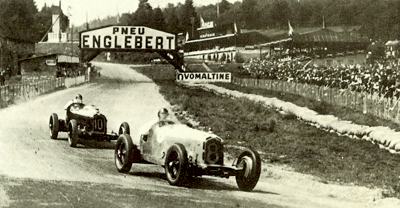Raymond Sommer was the son of Roger Sommer, a wealthy manufacturer of felt, who from 1909 to 1912 had been one of France's best-known pioneer aviators and manufacturers of aircraft, but had sold his aviation business to MM Bathiat and Sanchez-Besa in 1913 and returned from aviation to the less exciting but more remunerative business of making felt slippers.
Thus young Raymond, born in 1906, was brought up in an atmosphere of 'mechanical sport and progress'; he first started motor racing with a 4.6-litre Chrysler straight-eight, which had a carburettor for each cylinder, and, though he retired at Le Mans in 1931, he and his co-driver Delemer won the sports car class in the Belgian 24 hours'race at Spa.
In March 1932, still driving the Chrysler, he was first in the general classification of the Paris-Nice Trial, and also set a new class record in the La Turbie hill-climb. Soon afterwards, he bought an
8C 2300 Alfa Romeo and, by way of a try-out, won the Torvilliers race at Troyes.
With Luigi Chinetti as co-driver, he entered the Alfa for the 24 Heures du Mans, and drove for 18 hours out of the 24 as his partner was unwell; the result was a victory for the equipe, with the Alfa covering 2954 km. A month later, Sommer came second in the Nice Grand Prix, while in September he won the Nice
Grand Prix with his 2.6 litre P3 Alfa, defeating
Nuvolari with spectacular ease and style.
Raymond Coeur de Lion
Nuvolari shared the Monza with Sommer in that year's Le Mans 24 hours, and despite frequent halts for fuel caused by a leaking petrol tank, the Alfa notched up Sommer's second victory in this event. Sommer's verve and courage at the wheel earned him the nickname of Raymond Coeur de Lion; he drove like a devil, it was said, and would never retire from a race while there was still hope, even when a breakdown had lost him all chance of winning.
Driving a Maserati, he was third in the 1935 Belgian Grand Prix; with a new 3.2-Iitre Alfa P3 he won the Comminges
Grand Prix and was third in the Marne GP, while 1936 saw him take fourth place in the Vanderbilt Cup on the Roosevelt Raceway. Just before World War 2, in 1937 and 1939, Sommer earned himself the title of Champion of France. When war broke out, he was refused a commission in the French Army, preferring to fight as an ordinary poilu: even so, he still managed to shoot down a low-flying German aeroplane with his rifle.
Freeing Doctor Porsche from Dijon
After the war, backed by veteran motoring journalist Charles Faroux, Sommer was at the head of the unpopular - but eventually successful - campaign to free Doctor Porsche from Dijon prison, and was soon back in motor racing, coming second in the very first post-war event, organised in the Buis de Boulogne in 1945. The following season saw victories in the Marseille Grand Prix, the Circuit de Trois Villes and the St Cloud GP, a second in the Turin
Grand Prix and the Brussels Meeting, a list of successes which were enough to secure his third French championship. In 1947, Sommer crashed at Pau, nearly biting off his tongue in the impact, and was eliminated from both the
Grand Prix d'Europe at
Spa and the Prix de la Marne at Reims after his Maserati chassis frame broke on both occasions.
 Raymond Sommer at the wheel of an Alfa Romeo
Raymond Sommer at the wheel of an Alfa Romeo
in the 1933 at the Belgian Grand Prix. |
He then tried the CTA-Arsenal at Lyon - it broke its back axle on the starting line. His luck seemed to have changed at Turin, at the wheel of one of the new V12 2-litre Ferraris, and led all the way from the start, running away from the rest of the field with consummate ease and making the fastest lap of 69.88 mph and recording an average of 67.5 mph over the 312.5 mile distance. He raced a Talbot in 1948 and 1949, and drove the unlucky 16-cylinder
BRM in its debut at Silverstone but, recalling the CTA-Arsenal, its transmission broke on the starting line.
Drive your hardest, take the lead early and frighten off the opposition if possible
Then, while taking part in the unimportant Haute Garonne
Grand Prix on the Gardours circuit on 10 September 1950, Sommer crashed fatally in his 1100 cc Cooper, apparently the victim of a seized wheel bearing. 'Drive your hardest, take the lead early and frighten off the opposition if possible,' had been Raymond Sommer's credo. Not long before his death, France had awarded him the Cross of the Legion of Honour as 'the greatest driver in the country.'



